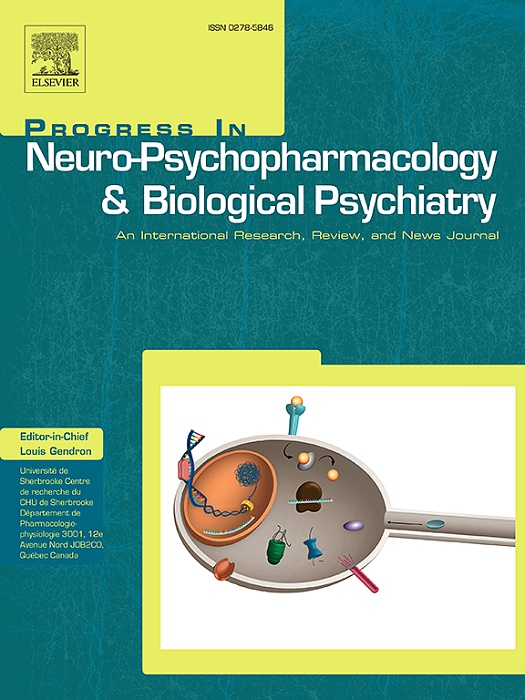高危精神状态个体大脑皮层测量的结构协方差增加。
IF 5.3
2区 医学
Q1 CLINICAL NEUROLOGY
Progress in Neuro-Psychopharmacology & Biological Psychiatry
Pub Date : 2024-11-22
DOI:10.1016/j.pnpbp.2024.111197
引用次数: 0
摘要
据报道,精神分裂症患者的结构协方差模式异常,这被认为代表了大脑成熟和神经发育过程中的连接组变化。目前还不清楚在精神病的临床高危状态下是否存在类似的差异,也不清楚这些差异是否与前驱表型和/或精神病的后期发病有关。这项多中心磁共振成像研究横截面检查了具有不同结果的高危精神状态(ARMS)大样本的结构协方差。研究评估了155名ARMS患者和191名健康对照者的全脑结构协方差,其中包括四种皮质测量指标(厚度、面积、体积和回旋化),ARMS患者被细分为26名(16.8%)精神病发病较晚者(ARMS-P)、44名阈下精神病性症状持续存在者、53名精神病性症状缓解者(ARMS-R)。我们还在 ARMS 子样本中研究了结构协方差的变化与临床症状和认知障碍之间的关系。在广泛的皮质区域,ARMS 组的结构协方差明显高于对照组,在受影响的皮质区域,每种皮质测量指标都有不同的模式。皮质区域较高的结构协方差部分与严重的多疑-逼迫性意念有关。ARMS-P组的结构协方差明显高于ARMS-R组,主要表现在前顶回。本研究结果表明,结构协方差的变化导致了精神病的易感性,而ARMS受试者大脑回旋结构协方差过大可能会导致他们日后的临床病程。本文章由计算机程序翻译,如有差异,请以英文原文为准。
Increased structural covariance of cortical measures in individuals with an at-risk mental state
An anomalous pattern of structural covariance has been reported in schizophrenia, which has been suggested to represent connectome changes during brain maturation and neuroprogressive processes. It remains unclear whether similar differences exist in a clinical high-risk state for psychosis, and if they are associated with a prodromal phenotype and/or later psychosis onset. This multicenter magnetic resonance imaging study cross-sectionally examined structural covariance in a large at-risk mental state (ARMS) sample with different outcomes. The whole-brain structural covariance of four cortical measures (thickness, area, volume, and gyrification) was assessed in 155 individuals with ARMS, who were subclassified into 26 (16.8 %) with a later psychosis onset (ARMS-P), 44 with persistent subthreshold psychotic symptoms, and 53 with the remission of psychotic symptoms (ARMS-R) during the clinical follow-up, and 191 healthy controls. The relationships of changes in structural covariance with clinical symptoms and cognitive impairments were also investigated in the ARMS subsample. Structural covariance was significantly higher in widespread cortical regions in the ARMS group than in the controls, with each cortical measure having a different pattern in affected cortical regions. The higher structural covariance of the cortical area was partly related to severe suspiciousness–persecutory ideation. Structural covariance was significantly higher, mainly in fronto-parietal gyrification, in the ARMS-P group than in the ARMS-R group. The present results suggest that changes in structural covariance result in psychosis vulnerability and the excessive structural covariance of brain gyrification in ARMS subjects may contribute to their later clinical course.
求助全文
通过发布文献求助,成功后即可免费获取论文全文。
去求助
来源期刊
CiteScore
12.00
自引率
1.80%
发文量
153
审稿时长
56 days
期刊介绍:
Progress in Neuro-Psychopharmacology & Biological Psychiatry is an international and multidisciplinary journal which aims to ensure the rapid publication of authoritative reviews and research papers dealing with experimental and clinical aspects of neuro-psychopharmacology and biological psychiatry. Issues of the journal are regularly devoted wholly in or in part to a topical subject.
Progress in Neuro-Psychopharmacology & Biological Psychiatry does not publish work on the actions of biological extracts unless the pharmacological active molecular substrate and/or specific receptor binding properties of the extract compounds are elucidated.

 求助内容:
求助内容: 应助结果提醒方式:
应助结果提醒方式:


